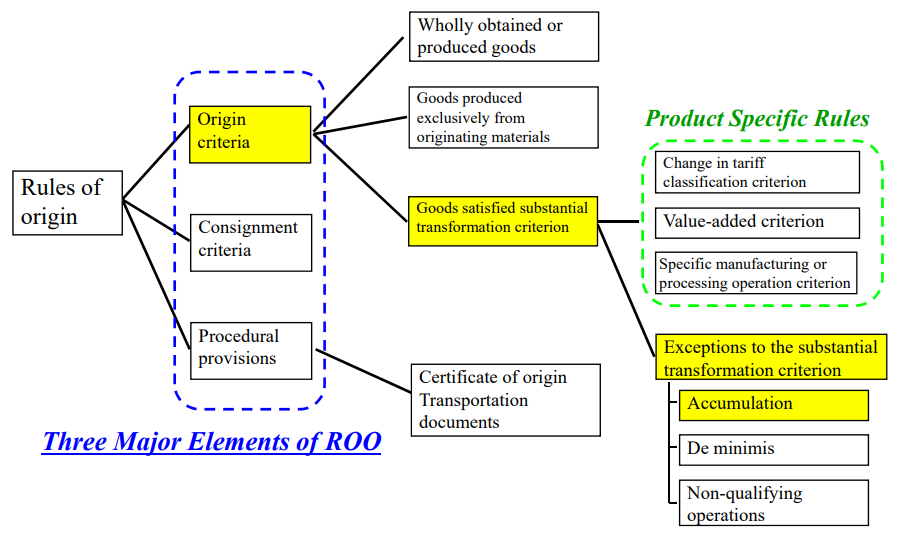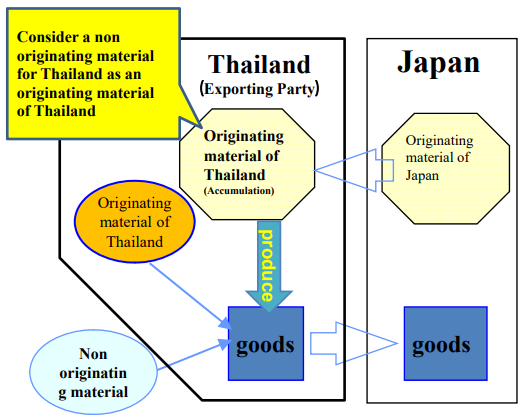The basic concept of accumulation is to consider an originating material of
other Party as an originating material of the Party in which production
of a good takes place.

Retrieved from: Outline of Rules of Origin for EPA in Japan
The accumulation concept applies to both Change in Tariff Classification (CTC) and
Regional Value Content (RVC). With accumulation, an applicant is encouraged to procure
originating raw materials from within the Party(ies) of the same Free Trade Agreement (FTA)
since these materials will be treated as though they are locally produced.
Table of Contents
Example of “JTEPA” accumulation
Under the accumulation provision of The Japan–Thailand Economic Partnership
Agreement (JTEPA),a producer in Thailand is able to treat imported materials that
are of Japan origin as though they are of Thailand origin when determining whether the
good meets the Rules of Origin (ROO) requirements to be considered as an
originating good.
To use this provision, the producer would have to prove that the imported materials from
Japan are originating materials under JTEPA. She would have to obtain the Preferential
Certificate of Origin (CO) under JTEPA to demonstrate that they are originating materials
under JTEPA.

Retrieved from: Outline of Rules of Origin for EPA in Japan
An originating material of Japan which is used for the production of a good in
Thailand may be considered as an originating material of Thailand.
Example of “ATIGA” accumulation
Under the accumulation provision of the ASEAN Trade In Goods Agreement
(ATIGA), a producer in Singapore is able to treat imported materials that are of Malaysia
origin as though they are of Singapore origin when determining whether the good meets the
Rules of Origin (ROOs) requirements to be considered as an originating good. To use this
provision, the producer would have to prove that the imported materials from Malaysia are
originating materials under ATIGA. She would have to obtain the Preferential Certificate of
Origin (CO) under ATIGA (i.e. Form D) to demonstrate that they are originating materials
under ATIGA.
Case study in Accumulation
Biscuit case (HS 1905.31)

FTA: the ASEAN Trade In Goods Agreement (ATIGA)

Malaysia is a Party of ATIGA but Australia is not. As such, the producer of biscuit in
Singapore can now accumulate the imported flour and eggs and treat them as though they
are of Singapore origin.

Assessment: The RVC of the biscuit is 83% (more than 40%). As the biscuit now meets
the ROO requirement under ATIGA, it is an originating good.
Solar paste case (HS 3207.30)
FTA: ASEAN-Japan Comprehensive Economic Partnership (AJCEP)

Since the Glass powder used is actually more than 10% of the FOB value of Solar
paste. The Solar paste would have become a non-originating good under AJCEP since it
has failed the CTC and de minimis requirement.
However, since Malaysia is a Party of AJCEP, the producer of Solar Paste in Singapore
can now accumulate the imported Glass powder and treat them as though it is of
Singapore origin.
Assessment: The Solar paste now meets the CTC requirement under AJCEP, it is an
originating good.
Images Retrieved from:Handbook on Rules of Origin for Preferential Certificates of Origin
